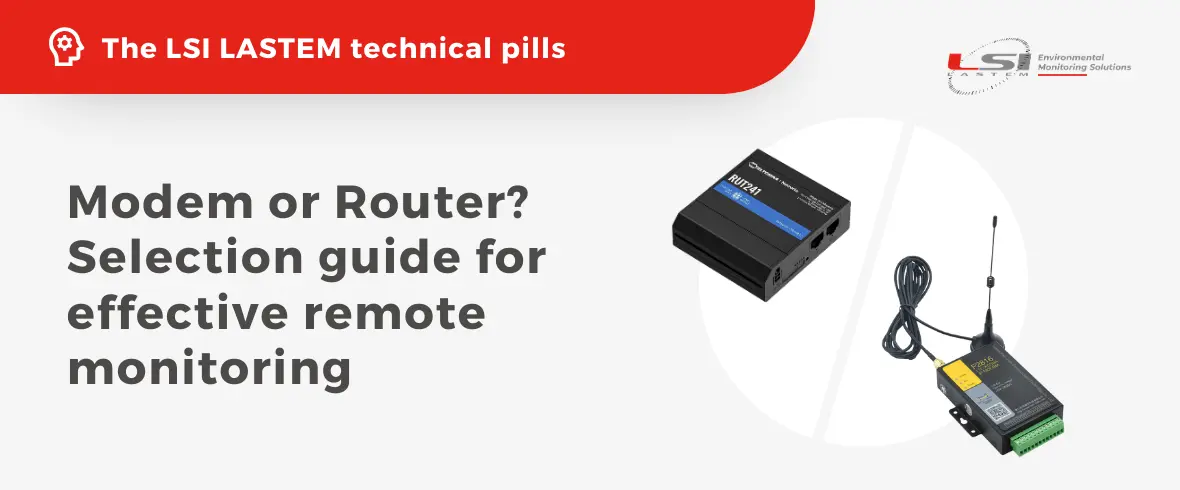Modem or Router? Selection guide for effective remote monitoring

When it comes to configuring a monitoring system with remote communication, it becomes essential to identify which is the most suitable tool for sending data. The choice between modem and router is not always immediate and depends on the specific needs of the customer, the installation site and the type of equipment installed. This technical pill aims to help the customer choose the most suitable instrument for their monitoring needs and which can guarantee optimal operation of the station.
What is a modem?
The modem is a transceiver device that plays a key role in the transmission of data in both analog and digital form. The term “modem” comes from its main function of MODulation and DEModulation, which involves the conversion of bit sequences into electrical signals.
Basically, the modem is a telephone connection device that is used to connect a terminal, such as a data logger, to a data transmission network. In practice, this means that the modem converts, then modulates, digital signals into analog pulses during transmission and, conversely, demodulates analog pulses into digital signals during reception. There are modem models that can be connected either to the landline or to mobile networks through the use of a SIM card.
Application and advantages of modem
The mobile modem supplied by LSI LASTEM is mainly used with devices that only have an RS232 serial interface and in situations where low power consumption is required.
Pros: energy efficiency and SMS functionality
- Low power consumption: the modem offers low power consumption, ideal for situations where energy efficiency is essential;
- Possibility of sending SMS: thanks to the modem, it is possible to send SMS with monitoring data, useful in many applications.
Cons: SIM required, RS232 interface and other considerations
- Configuration interface not accessible remotely: modem configuration can be complex remotely, making remote management difficult;
- Need for a SIM card: a SIM card is always required, which limits the possibility of interfacing the modem to a local network (LAN or WI-FI);
- RS232 interface only: the modem only supports the RS232 interface, limiting compatibility with other devices;
- Narrowband data transmission: the modem has a limited data transmission capacity compared to a router.
What is a router?
A router is a network device that usually has Wi-Fi connectivity and is responsible for managing data packets entering or leaving one or more nodes of a computer network. This network can be either local, such as a LAN, or geographically extended, such as the Internet.
Additionally, “routing tables” are stored within the router that allow data packets in transit to understand the topography of the network and select the most efficient path to reach their destination. Finally, as with modems, there are routers that can be connected to fixed networks or mobile networks through the use of a SIM card.
Use and advantages of the router
The router supplied by LSI LASTEM can be used in all contexts in which the acquisition devices are connected via a broadband Ethernet or Wi-Fi interface.
Pros: connection flexibility, multi-device management, remote configuration
- Ability to connect to a Wi-Fi and 4G/5G network: the router offers flexibility, allowing connection to both Ethernet and wireless networks, including 4G/5G services through the SIM card;
- Multi-device management: a router allows the simultaneous management of multiple devices, ideal for complex installations;
- Remotely accessible configuration interface: the router’s configuration interface is easily accessible remotely, simplifying remote management;
- Easy setup and compatibility: the router is generally easy to setup and is compatible with a wide range of capture devices;
- Always on and self-restoring connection: the router offers the possibility of maintaining an always active and self-restoring connection in the event of interruptions;
- The router is also a modem: while the modem is one-way, the router acts as a modem and a router, offering a versatile option.
Cons: high power consumption
- Higher consumption: the router tends to have higher energy consumption than the modem;
- Does not allow sending SMS: unlike the modem, the router usually doesn’t support the SMS sending function.
Conclusions
- The choice between modem and router depends on the specific monitoring needs and installation conditions. The modem offers low power consumption and the ability to send SMS, but has some limitations in terms of remote configuration. On the other hand, the router offers greater flexibility, multi-device management and a more accessible configuration interface, but has higher power consumption and does not allow sending SMS. Customers should carefully evaluate these features to make an informed decision that is suitable for their specific installation.
